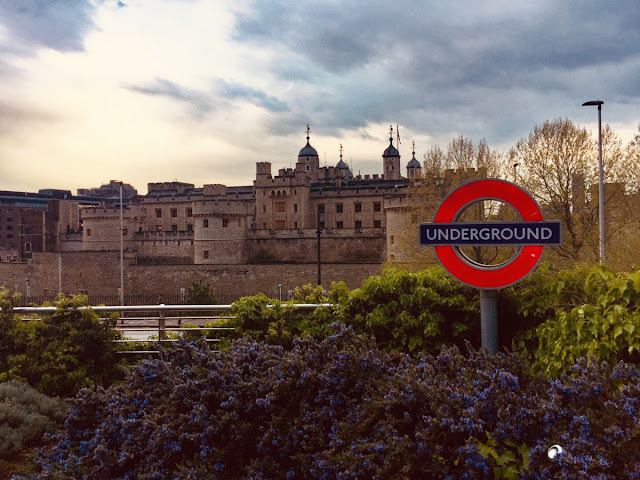London Tower Hill and Tower Bridge
Another visit to London for training reasons had been arranged in the new headquarter of our company. It happened to be just around another tourist's hot-spot.
A quick walk along the Tower Hill strikes with places rich in power and the past. This is the most important area not only in London's history but the whole of the British Isles.
 |
| Tower of London view from the north side |
Among the many royal palaces and castles on the British soil, the Tower of London is a symbol of British history.
Surviving from the earliest moment of the Norman conquest in 11th century, its layout has been established by the 13th century and remained largely intact.
 |
| Tower Hill Underground Station |
Most of all, it is a symbol of the Norman ruling class that invaded Anglo-Saxon Britain a thousands years ago, that built castles and palaces and had been granted privileges and land.
The remains of this rule and a social divide are still present in the British society. The aristocracy and the Royal Family today are considered as the unattainable top-notch over the common masses, although they are more or less of cultural significance.
The Tower of London lost it's direct connection with power, apart from one significant symbol, the Crown Jewels. In some way, it still is the seat of sort-of-spiritual power, if we want to see the many crowns of the British monarch in that light (and if we decide to pay a visit - with money and time).
 |
| The animal sculptures commemorate the Royal Menagerie, and the 19th century zoo |
The Tower of London had served as the royal seat, as a prison, as a zoo, a register office, a museum, and a tourist attraction. It's purposes have been changing as the needs of any particular time in history.
 |
| The Tower was also a prison since 1100 until 1952, when the infamous gangsters, the Kray brothers were held there. |
There were quite a few public executions on its grounds, the lasts during the Second World War.
The most famous execution act the Tower is affiliated with is the beheading of Anne Boleyn, the most known wife of the most known British king, Henry VIII. Their marriage was at the same time a pivotal point in breaking the ties with the Catholic Church and the establishment of the Church of England.
Anne Boleyn was imprisoned in the Tower before her execution. So was her daughter, the young princess, Elisabeth, but her tenure ended up quite differently - her head was crowned.
She became one of the most famous Queens in world history, Elisabeth I.
 |
| London Wall, the last preserved fragment from the city walls |
This area on the River Thames was of crucial importance not only to Normans. The formidable fortification of the Tower of London are near to the remains of ancient Roman fortified walls, predeceasing the Tower complex by almost another thousand years.
The Romans walls were incorporated into the Norman layout of the city, expanded and cared for as the city walls - as in many medieval towns. They marked the boundaries of the old city. Now, only a few fragments are still standing.
 |
| The statue of Roman emperor, Trajan |
Trajan had been one of the greatest Roman emperors, with a good heart and wise command, successful in military expansion of the Roman Empire as well, as in the public reforms and social welfare.
Perhaps, the old vicar had thought it is a good idea to have him there, at the old seat of the British power - as a reminder that the rulers, kings, emperors, governors can be both politically successful and at the same time - honestly care about the prosperity of the common people.
This might be the reason, we think, because Trajan never set his foot on the British soil, so why have him there?
 |
| The Tower Bridge, one of the London's main landmarks |
If we would ask: What is the most known symbol of London? - many people would answer - the Big Ben, of course - the clock tower of the Palace of Westminster, a 3 miles way eastwards from the Tower Hill, where the seat of power - the Parliament - now is. (You can get there, virtually, now: London on Foot - a Cultured Walk through the West End and Westminster.)
The second answer to the above question, for many, would be - the Tower Bridge.
 |
| Tower Bridge is confusingly and commonly named - the London Bridge |
Tower Bridge, connects the Tower Hill and the Tower of London with the south bank of the Thames, where the modernistic architecture of the City Hall is - the seat of Mayor of London. It became a powerful marketing spot for London. Erected by the Victorians who loved the neo-gothic architecture - so it would look like an old Middle Ages construction.
The London Bridge, is an uninteresting piece of architecture, its practical use connects the London Bridge Station and another modern landmark, the Shard ( London Modern Landmarks - The Shard) with the north bank of the Thames - the City of London, the centre of global financial power (Ye Olde City of London - Where the Gold and Money Rule).
There is a very nice stroll along the south bank between the two bridges, in fact - one of the best, if you want to catch the London vibe and the best of London cityscape.
 |
| The walk along south bank of the Thames between Tower Bridge and the London Bridge |
But is you have a less time to spare - the Tower of London, the London Wall and the Tower Bridge - all three in one cluster on the Tower Hill - are easy to visit and fun to explore.